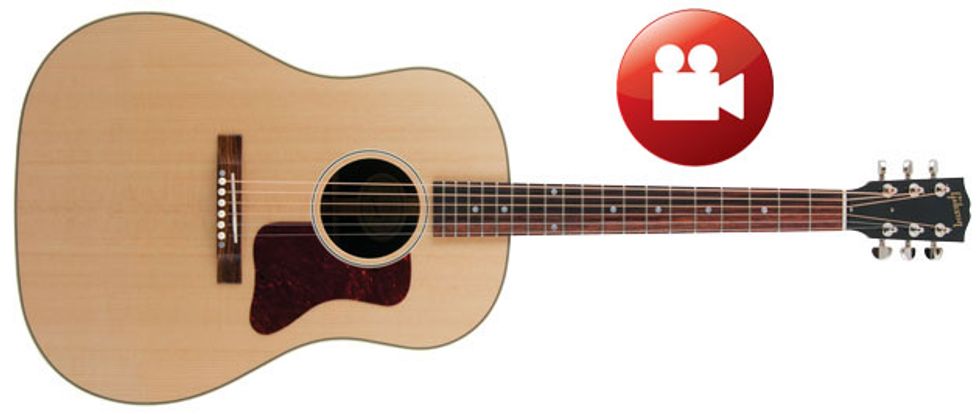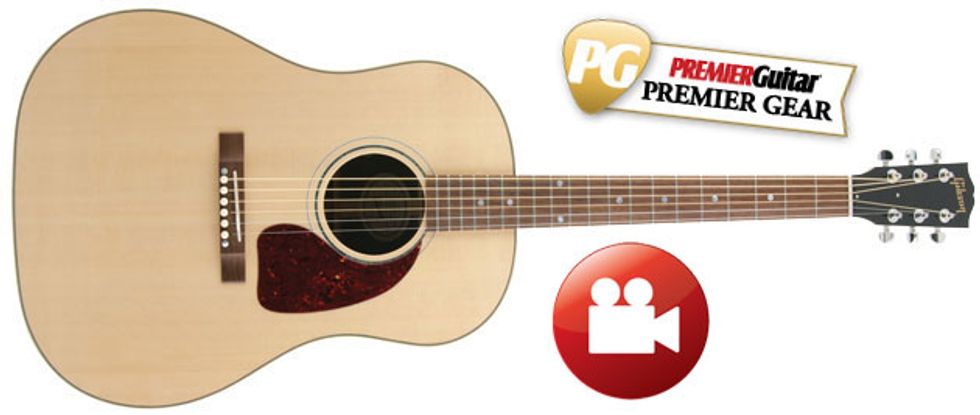Gibson’s slope-shouldered dreadnoughts are among the guitar universe’s truly great designs. The convergence of curves and understated ornamentation are a study in proportional perfection, with the sort of simplicity and subdued, utilitarian elegance that makes Eames chairs, Coke bottles, and Boeing 707s iconic.
Though the mahogany-and-spruce J-45 is the most famous manifestation of the slope-shouldered profile, the shape has been the foundation for other Gibsons, including the J-35, the natural finished J-50, the 25 1/2"-scale Advanced Jumbo, the rare B-45 12-string, and the J-160 made famous by the Beatles. Gibson still produces many of these guitars, but the new J-15 and J-29 are the first new, non-signature-edition variations on the J body style in years—and very cool departures from the J-45’s sonic template.
J-29
The J-29 is the more traditional-looking of the new pair, but it’s a handsome devil. If you’ve grown accustomed to seeing slope-shouldered Gibsons in the classic J-45 sunburst, you’ll marvel at how attractive and visually balanced the profile looks in a natural blonde finish. The dramatically striped grain of the Indian rosewood back and sides beneath that nitrocellulose lacquer looks as deep and three-dimensional as an alpine lake.Ratings
Pros:
Sky-high headroom. Loud enough to hang in any picking circle. Pretty and understated.
Cons:
Upper mids can be brashly bright.
Tones:
Playability:
Build/Design:
Value:
Street:
$2,250
Gibson J-29
gibson.com
The J-29 isn’t the first or only rosewood-backed Gibson slope-shoulder. In fact, the company has built rosewood-backed J-45s quite recently. But it’s a compelling alternative for any player who loves the slope-shoulder style, but prefers the stronger projection of a rosewood, square-shouldered Gibson or a rival like the Martin D-28.
The J-29 has amazing headroom. It’s a fantastically loud guitar if you want it to be—you can positively hammer the thing with a flatpick without generating confused harmonics. You get projection and raw horsepower that rivals any dread. The trade-off for all this volume—one many players will like—is brash, bright upper mids, which can get white-hot at times. These qualities remain pronounced through the otherwise agreeable and transparent L.R Baggs Element electronics. If you’re a rock strummer, you’ll probably love the J-29’s power and presence in a band mix. Meanwhile, that dynamic sensitivity means that you don’t have to strum too vigorously to get it. That said, it can be hard to back the J-29 down into those softer, smokier moods at which the mahogany J-45 excels.
Our J-29 was set up with slightly higher action than the J-15, presumably to highlight the guitar’s ample horsepower and definition when flatpicked. While the J-29 can excel at fingerstyle—especially high-harmonic detail in open tunings—it has a fast, excitable reactivity most at home in rock, bluegrass, and country.
J-15
The more affordable of the new Gibsons is also the more soft-spoken. But while it’s less explosive than the J-29, the J-15 is a very playable and flexible instrument. It’s also one of the most unique-looking J-bodies ever built.Like the J-29, the J-15 has a solid Sitka spruce top with a nitrocellulose lacquer finish. The back and sides, however, are American walnut. The grain undulates like sheets of rain cascading down a windowpane. More striking still (at least to the eyes of Gibson traditionalists) is the blonde-finished maple neck, whose rosewood skunk stripe lends a European touch.
Ratings
Pros:
Excellent overtone balance. Distinctive, dry voice. Cool twist on the traditional Gibson slope-shouldered style. Surprising headroom.
Cons:
Lacks some warmth of a mahogany-backed slope-shouldered Gibson.
Tones:
Playability:
Build/Design:
Value:
Street:
$1,500
Gibson J-15
gibson.com
Except for one minor detail, the J-15’s construction is excellent. Unfortunately, a roughly cut section of bracing is plainly visible when you peek into the soundhole from a playing position. The fact the problem could have been solved with a few seconds of light sanding makes the oversight doubly frustrating.
The J-15’s sandy shades evoke the arid beauty of the high desert, and its sound conjures similar images. It’s a bright, dry, husky voice that can sound almost thin after playing the more bombastic J-29. In reality, the J-15 is a very dynamic guitar that generates plentiful shades in response to your playing.
Like the 29, the 15 has sky-high headroom, though it’s a sky of a different hue. The controlled, balanced tone spectrum suggests a cross between mahogany and maple, with a an almost classical guitar-like overtone bloom. The J-29 strikes you with its brawn and near-blinding brightness when picked hard, while the J-15 dazzles with airy high midrange, a rainbow of overtones, and excellent string definition.The overtones, however, are softer than those of the J-29, which helps the J-15 nestle unobtrusively behind vocals. It’s a great match for the Element electronics. The J-15’s harmonic richness and focus makes it an easy guitar to record, particularly for spare fingerstyle arrangements than can showcase the instrument’s subdued-to-bright dynamics.
The Verdict
One of the coolest things about the J-15-and J-29 is that they represent genuine alternatives—not only to traditional round-shoulder Gibsons, but to each other. Rockers and bluegrass pickers itching to be heard over that dude with the pre-war D-28 will love the J-29’s high-mid presence, volume, and seemingly infinite headroom. Fingerstylists, moodier singer/songwriters, and recording guitarists will love the J-15’s dynamic breadth and dry, husky tone. Dyed-in-the-wool slope-shoulder Gibson devotees who savor the sonic nuances of vintage J-45s and Southern Jumbos may not love either guitar (though I suspect they’d favor the woody mellowness of the J-15). But the bottom line is that Gibson has expanded the sonic range of one the most attractive acoustic body shapes ever conceived.
At $1,500 bucks for the J-15 and $2,250 for the J-29 (yes, good rosewood is very expensive these days, darling), the guitars are destined to duke it out with many other excellent guitars in this competitive price bracket. But these unique and wonderful-sounding instruments seem destined to carve a niche all their own.
Watch the Review Demo:























